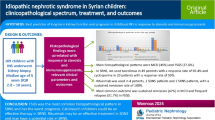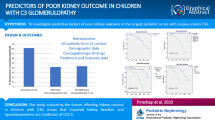Abstract
Background
Most cases of childhood nephrotic syndrome (NS) are due to minimal change disease (MCD), while a minority of children have focal segmental glomerulosclerosis (FSGS) and an unfavorable clinical course, requiring a kidney biopsy to confirm diagnosis. We hypothesized that clinical characteristics at diagnosis and initial response to corticosteroid treatment accurately predict FSGS and can be used to guide consistent practice in the indications for kidney biopsy.
Methods
This was a case control study (1990–2012). Inclusion criteria included age 1–17 years, meeting the diagnostic criteria for NS, and having biopsy-proven FSGS or MCD. Clinical characteristics at diagnosis included age, kidney function [estimated glomerular filtration rate (eGFR)], hypertension, hematuria, nephritis (reduced eGFR, hematuria, hypertension), and response to steroids.
Results
From a total of 169 children who underwent kidney biopsy for NS we included 65 children with MCD and 22 with FSGS for analysis. There were no significant between-group differences in age, sex, or eGFR at the time of diagnosis. The FSGS group had a higher proportion of hypertension (40 vs. 15%; p = 0.02), hematuria (80 vs. 47%; p = 0.01), and nephritis (22 vs. 2%; p = 0.004) and was more likely to be steroid resistant after 6 weeks of treatment than the MCD group (67 vs. 19%; p < 0.001). As predictors of FSGS, hematuria had a high sensitivity of 0.80 [95% confidence interval (CI) 0.56–0.93] and low specificity of 0.53 (95% CI 0.39–0.66), nephritis had a low sensitivity of 0.22 (95% CI 0.07–0.48) and high specificity of 0.98 (95% CI 0.88–0.99), and steroid resistance had a low sensitivity of 0.67 (95% CI 0.43–0.85) and high specificity of 0.81 (95% CI 0.68–0.90). The combination of steroid resistance after 6 weeks of therapy and/or nephritis at diagnosis yielded the optimal sensitivity and specificity at 0.80 (95% CI 0.56–0.93) and 0.75 (95% CI 0.60–0.86), respectively, confirmed by the highest receiver operator characteristic area under the curve of 0.77.
Conclusion
Steroid resistance after 6 weeks of therapy and/or nephritis at initial presentation is an accurate predictor of FSGS in children with NS and will be used as the indication for kidney biopsy in our newly developed clinical pathway. This approach will maximize the yield of diagnostic FSGS biopsies while minimizing the number of unnecessary MCD biopsies.

Similar content being viewed by others
References
El Bakkali L, Rodrigues Pereira R, Kuik DJ, Ket JC, van Wijk JA (2011) Nephrotic syndrome in The Netherlands: a population-based cohort study and a review of the literature. Pediatr Nephrol 26:1241–1246
Spencer JD, Hastings MC, Wyatt RJ, Ault BH (2012) Has the incidence of childhood steroid sensitive nephrotic syndrome changed? Clin Nephrol 78:112–115
McKinney PA, Feltbower RG, Brocklebank JT, Fitzpatrick MM (2001) Time trends and ethnic patterns of childhood nephrotic syndrome in Yorkshire, UK. Pediatr Nephrol 16:1040–1044
Chanchlani R, Parekh RS (2016) Ethnic differences in childhood nephrotic syndrome. Front Pediatr 4:39
Chesney RW (1999) The idiopathic nephrotic syndrome. Curr Opin Pediatr 11:158–161
Churg J, Habib R, White RH (1970) Pathology of the nephrotic syndrome in children: a report for the international study of kidney disease in children. Lancet 760:1299–1302
Ellis D, Kapur S, Antonovych TT, Salcedo JR, Yunis EJ (1978) Focal glomerulosclerosis in children: correlation of histology with prognosis. J Pediatr 93:762–768
Cameron JS, Turner DR, Ogg CS, Chantler C, Williams DG (1978) The long-term prognosis of patients with focal segmental glomerulosclerosis. Clin Nephrol 10:213–218
Arbus GS, Poucell S, Bacheyie GS, Baumal R (1982) Focal segmental glomerulosclerosis with idiopathic nephrotic syndrome: three types of clinical response. J Pediatr 101:40–45
Tejani A, Nicastri AD, Sen D, Chen CK, Phadke K, Adamson O, Butt KM (1983) Long-term evaluation of children with nephrotic syndrome and focal segmental glomerular sclerosis. Nephron 35:225–231
Yoshikawa N, Ito H, Akamatsu R, Matsuyama S, Hasegawa O, Nakahara C, Matsuo T (1986) Focal segmental glomerulosclerosis with and without nephrotic syndrome in children. J Pediatr 109:65–70
Tufro-McReddie A, Alvarez E, Arrizurieta E, Repetto H (1992) Focal glomerulosclerosis in children: an Argentinian experience. Pediatr Nephrol 6:158–161
Mongeau JG, Robitaille PO, Clermont MJ, Merouani A, Russo P (1993) Focal segmental glomerulosclerosis (FSG) 20 years later. From toddler to grown up. Clin Nephrol 40:1–6
Martinelli R, Okumura AS, Pereira LJ, Rocha H (2001) Primary focal segmental glomerulosclerosis in children: prognostic factors. Pediatr Nephrol 16:658–661
Eddy AA, Symons JM (2003) Nephrotic syndrome in childhood. Lancet 362:629–639
Abrantes MM, Cardoso LS, Lima EM, Silva JM, Diniz JS, Bambirra EA, Oliveira EA (2006) Clinical course of 110 children and adolescents with primary focal segmental glomerulosclerosis. Pediatr Nephrol 21:482–489
Kidney Disease (2012) Improving global outcomes (KDIGO) glomerulonephritis work group. KDIGO clinical practice guideline for glomerulonephritis. Kidney Int Suppl 2:139–274
Samuel S, Bitzan M, Zappitelli M, Dart A, Mammen C, Pinsk M, Cybulsky AV, Walsh M, Knoll G, Hladunewich M, Bargman J, Reich H, Humar A, Muirhead N (2014) Canadian Society of Nephrology Commentary on the 2012 KDIGO clinical practice guideline for glomerulonephritis: management of nephrotic syndrome in children. Am J Kidney Dis 63:354–362
[No authors listed] (1978) Nephrotic syndrome in children: prediction of histopathology from clinical and laboratory characteristics at time of diagnosis. A report of the International Study of Kidney Disease in Children. Kidney Int 13:159–165
Kumar J, Gulati S, Sharma AP, Sharma RK, Gupta RK (2003) Histopathological spectrum of childhood nephrotic syndrome in Indian children. Pediatr Nephrol 18:657–660
Nammalwar BR, Vijayakumar M, Prahlad N (2006) Experience of renal biopsy in children with nephrotic syndrome. Pediatr Nephrol 21:286–288
Gulati S, Sharma AP, Sharma RK, Gupta A, Gupta RK (2002) Do current recommendations for kidney biopsy in nephrotic syndrome need modifications? Pediatr Nephrol 17:404–408
Chesney R (2004) The changing face of childhood nephrotic syndrome. Kidney Int 66:1294–1302
Bonilla-Felix M, Parra C, Dajani T, Ferris M, Swinford RD, Portman RJ, Verani R (1999) Changing patterns in the histopathology of idiopathic nephrotic syndrome in children. Kidney Int 55:1885–1890
Filler G, Young E, Geier P, Carpenter B, Drukker A, Feber J (2003) Is there really an increase in non-minimal change nephrotic syndrome in children? Am J Kidney Dis 42:1107–1113
Schwartz GJ, Munoz A, Schneider MF, Mak RH, Kaskel F, Warady BA, Furth SL (2009) New equations to estimate GFR in children with CKD. J Am Soc Nephrol 20:629–637
National High Blood Pressure Edcuation Working Group on High Blood Pressure in Children and Adolescents (2004) The fourth report on the diagnosis, evaluation, and treatment of high blood pressure in children and adolescents. Pediatrics 114:555–576
[No authors listed] (1982) Early identification of frequent relapsers among children with minimal change nephrotic syndrome. A report of the International Study of Kidney Disease in Children. J Pediatr 101:514–518
Silverstein DM, Craver R (2007) Presenting features and short-term outcome according to pathologic variant in childhood primary focal segmental glomerulosclerosis. Clin J Am Soc Nephrol 2:700–707
Gipson DS, Chin H, Presler TP, Jennette C, Ferris ME, Massengill S, Gibson K, Thomas DB (2006) Differential risk of remission and ESRD in childhood FSGS. Pediatr Nephrol 21:344–349
Gulati S, Sharma AP, Sharma RK, Gupta A (1999) Changing trends of histopathology in childhood nephrotic syndrome. Am J Kidney Dis 34:646–650
[No authors listed] (1981) The primary nephrotic syndrome in children. Identification of patients with minimal change nephrotic syndrome from initial response to prednisone. A report of the International Study of Kidney Disease in Children. J Pediatr 98:561–564
Gipson DS, Troost JP, Lafayette RA, Hladunewich MA, Trachtman H, Gadegbeku CA, Sedor JR, Holzman LB, Moxey-Mims MM, Perumal K, Kaskel FJ, Nelson PJ, Tuttle KR, Bagnasco SM, Hogan MC, Dell KM, Appel GB, Lieske JC, Ilori TO, Sethna CB, Fervenza FC, Hogan SL, Nachman PH, Rosenberg AZ, Greenbaum LA, Meyers KE, Hewitt SM, Choi MJ, Kopp JB, Zhdanova O, Hodgin JB, Johnstone DB, Adler SG, Avila-Casado C, Neu AM, Hingorani SR, Lemley KV, Nast CC, Brady TM, Barisoni-Thomas L, Fornoni A, Jennette JC, Cattran DC, Palmer MB, Gibson KL, Reich HN, Mokrzycki MH, Sambandam KK, Zilleruelo GE, Licht C, Sampson MG, Song P, Mariani LH, Kretzler M (2016) Complete remission in the nephrotic syndrome study network. Clin J Am Soc Nephrol 11:81–89
Gipson DS, Massengill SF, Yao L, Nagaraj S, Smoyer WE, Mahan JD, Wigfall D, Miles P, Powell L, Lin JJ, Trachtman H, Greenbaum LA (2009) Management of childhood onset nephrotic syndrome. Pediatrics 124:747–757
Author information
Authors and Affiliations
Consortia
Corresponding author
Ethics declarations
This was a case control study approved by the University of British Columbia and the British Columbia Children’s Hospital Research Ethics committees. Informed consent was waived as the study was deemed minimal risk and data were obtained through a chart review.
Conflict of interest
The authors declare no conflict of interest.
Electronic supplementary material
ESM 1
Identification of cases. A total of 420 children with the diagnosis “nephrotic syndrome” were identified, 348 from a clinical database and 169 from a biopsy database, with an overlap of 97 children. After exclusions, a total number of 178 children were identified: 22 were classified as cases of FSGS, all confirmed by biopsy, while 156 were identified as MCD. Of these, 91 were “presumed MCD”, and 65 were “biopsy-proven MCD”. (DOCX 41 kb)
Rights and permissions
About this article
Cite this article
Alshami, A., Roshan, A., Catapang, M. et al. Indications for kidney biopsy in idiopathic childhood nephrotic syndrome. Pediatr Nephrol 32, 1897–1905 (2017). https://doi.org/10.1007/s00467-017-3687-3
Received:
Revised:
Accepted:
Published:
Issue Date:
DOI: https://doi.org/10.1007/s00467-017-3687-3




